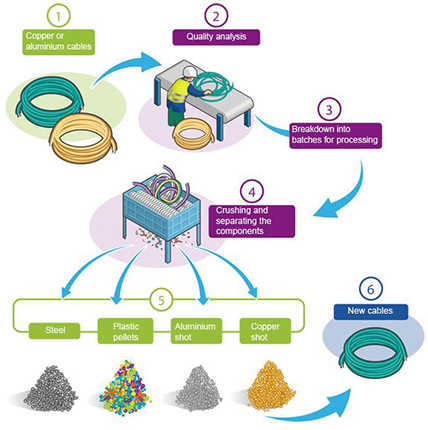|
|
Resource Innovation and Solutions Network
The following material was provided by the Arizona State University Walton Global Solutions Services and the Resource Innovation and Solutions Network.
This is the first in a three-part series about resource management.
Managing waste is becoming an increasingly significant challenge for municipalities around the globe. As landfills fill up and resource
extraction becomes more costly both financially and environmentally, cities and regions are in need of alternative solutions to the
existing waste system. Fortunately, the waste challenge has also opened up new opportunities for innovation, economic development and
creating positive impact through leading-edge resource management strategies. Three concepts that are changing the way societies dispose
their waste and reuse their materials are net positive, zero waste, and the circular economy. Net positive and zero waste describe more
general goals, defined as creating an overall positive impact in society and diverting at least 95% of waste, respectively. The circular
economy is a philosophy that prescribes a new approach to the creation and disposal of products by encouraging a transition from linear
production and waste processes to circular processes, mirroring the condition of nature that there is no waste.
In this three-part blog series, these concepts are described in more detail and the opportunities for them to be integrated as
complements to each other as a sustainable and economically-sound resource management strategies are discussed. The Global Sustainability
Solutions Services (GS3) of Arizona State University's Julie Ann Wrigley Global Institute of Sustainability is currently at work to advance
the potential of the circular economy in the Phoenix metropolitan area. In a collaborative effort, the city of Phoenix and GS3 have developed
the Resource Innovation and Solutions Network (RISN) to transform the Phoenix
valley's waste stream into a circular system and provide shared value throughout the region.
Part 2: The Unique Potential of the Circular Economy
Circular systems can be approached from both the front-end design process and the back-end waste management process. From the front-end perspective,
products and services should be designed with "end of life" in mind, such that the materials, water, air emissions and embodied energy can be rebuilt,
reused, repurposed or recycled into new products and services. From the back-end perspective, circular systems must ensure high rates of source
separation, have multiple uses for any given material, foster collaboration among waste generators and users and make local/regional use of materials
in order to reduce transportation and the financial and greenhouse gas costs associated with it.
From both front-end and back-end perspectives, a key principle of the circular economy is the separation of materials into biological and technical
nutrient cycles. Biological materials include food scraps, animal waste, green waste, paper and other cellulosic/fiber materials. They also include,
in a growing way, new products made from biological nutrients that were previously made from technical nutrients extracted from the ground, such as
compostable dinnerware made from bioplastics. The intent is to recycle the nutrients in these materials.
Back into the biosphere through composting, mulching or other emerging processes that break them down into fundamental components, like phosphorus,
nitrogen and so on.
A last resort is to turn them into energy, including heat, electricity, biogas and liquid fuels, through processes such as mass burn, pyrolysis,
gasification and fuel refining processes. These processes generally result in biochar that can be used in a variety of applications, such as a
soil amendment or for water cleaning, as long as the biochar is not contaminated with heavy metals or other contaminants.
Technical materials include all those extracted materials that go into the products we use, such as oil, plastics, metals and glass. The intent is
to continuously recycle, or "upcycle," the "technical nutrients" in these products in the "technosphere." Forever and ever. Under no conditions
should these materials be put back into the Earth's crust. Products containing technical materials must be carefully designed for end-of-life, so
that the nutrients can be extracted and reused through repurpose disassembly, remanufacturing and other techniques.
 Figure 1. http://www.emag.suez-environnement.com/en/pictures-recycling-waste-electrical-electronic-equipment-3873
Figure 1. http://www.emag.suez-environnement.com/en/pictures-recycling-waste-electrical-electronic-equipment-3873
A key is to ensure that separate circular systems exist for these two broad categories of nutrients and that they can be source separated
at end-of-life. That could require disassembly for those products that combine biological and technical materials. Such separation must
be simple and low cost.
The circular economy is an idealized goal that represents many challenges to changing the way we think about, design, use and handle products
and the resources they are made of. Of course, the many entities we work with span the spectrum from an unmanaged, informal, nearly non-existent
waste management system, to a comprehensive material management system that is in many ways already fully circular, or on the cusp thereof. Each
of these entities exist on a spectrum of materials management maturity and has a different set of challenges ahead of them to mature their system
to the highest level and to achieve the circular economy in their region, with the resulting economic, environmental and social benefits promised
by such approach. For those just beginning the journey, implementation of basic, well known waste management practices are a necessity. For those
that are well along, openness to experimentation and innovation are key to creating new processes, practices, products and markets.
While development along the maturity curve cannot be radically short-circuited, it is critical that the local and regional waste management systems
designed and built today be adaptable and flexible enough to become the regional circular material management systems of tomorrow.
There are many barriers on the road to circularity in the arenas of policy, design, production, distribution, consumption and overall material management,
including back end "waste" processing. Stay tuned for future discussions in this space of some of those key challenges. In the meantime, here's to a
circular future!
|
|
League of Arizona Cities and Towns
1820 W. Washington St.
Phoenix, AZ 85007
Phone: 602-258-5786
Fax: 602-253-3874
http://www.azleague.org
|
|
|

